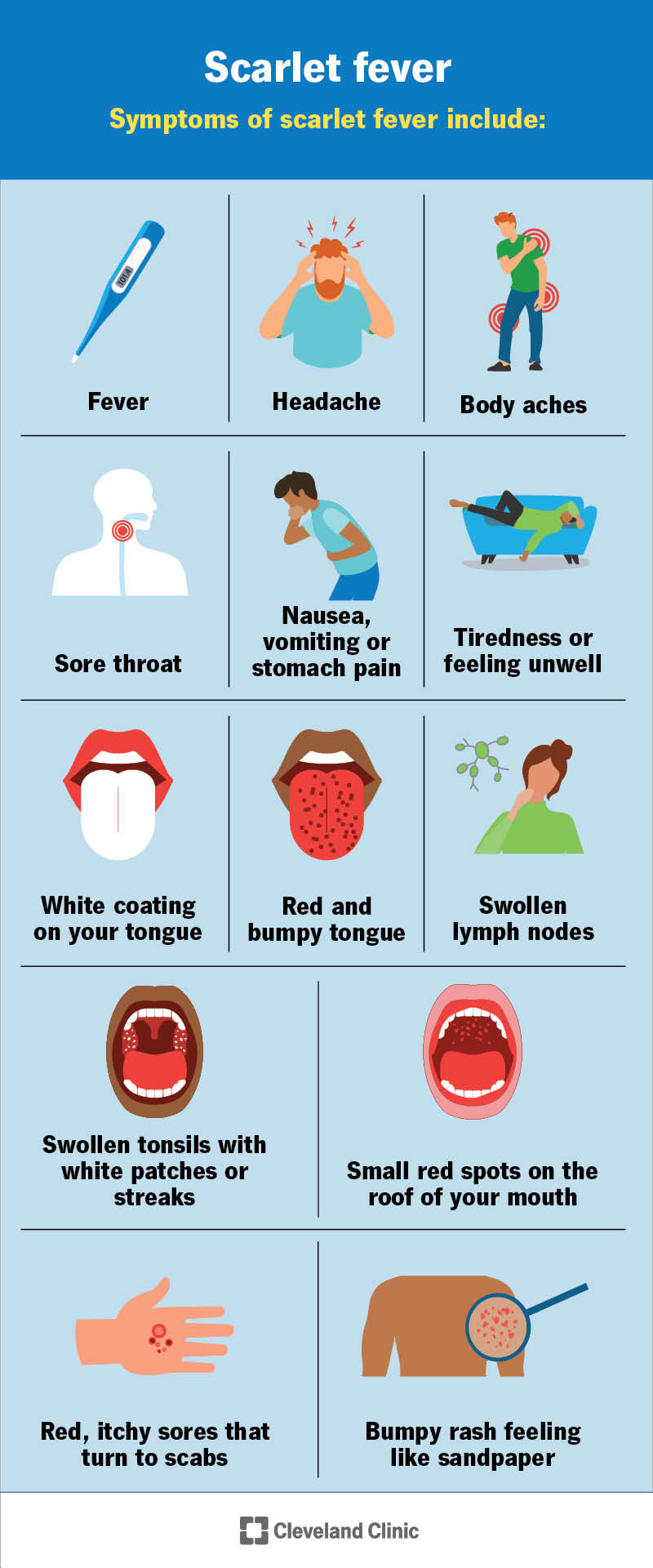Scarlet fever is a bacterial infection that causes a rough, bumpy rash over much of your body. The bacteria that cause it (strep A) also cause strep throat and skin infections. The rash usually appears after a few days of a sore throat, fever and other symptoms. It’s treatable with antibiotics.
Advertisement
Cleveland Clinic is a non-profit academic medical center. Advertising on our site helps support our mission. We do not endorse non-Cleveland Clinic products or services. Policy
Scarlet fever is a widespread rash you get from a group A strep infection. Group A strep is a type of bacteria that also causes strep throat and skin infections (impetigo). In fact, you most often get scarlet fever along with the symptoms of strep throat.
Advertisement
Cleveland Clinic is a non-profit academic medical center. Advertising on our site helps support our mission. We do not endorse non-Cleveland Clinic products or services. Policy
The rash is bumpy, rough and can spread over most of your body. It’s not harmful on its own, but the bacterial infection needs to be treated with antibiotics so it doesn’t progress to more serious health conditions.

Scarlet fever causes a distinctive, bumpy rash. You often have other symptoms a day or two before the rash shows up, including:
Scarlet fever rash is made up of tiny, rough bumps. It might feel a bit like sandpaper if you run your hand over it. If your skin is light, it’ll appear red or pink. If you have darker skin, it might look different from the surrounding skin, or it might be hard to see it. There’s often a pale area and/or a rash-free area around your mouth. Creases in the skin of your underarms, elbows and groin might be brighter red than the rest of the rash (pastia lines). Sometimes, the rash is itchy.
The rash might spread in stages:
Advertisement
Group A Streptococcus (strep A) bacteria cause scarlet fever. It’s the same bacteria that cause strep throat and impetigo, a skin infection. But not everyone who gets infected with the bacteria will get the rash.
Yes, the bacteria that cause scarlet fever are contagious (spread from person to person). People who are infected can easily spread it by coughing or sneezing, which sends tiny droplets that contain the bacteria into the air. You can get infected if you:
Some people who are infected get no symptoms but can still spread the bacteria to others.
Kids between the ages of 5 and 15 are at the highest risk for scarlet fever. Experts aren’t sure why some people develop a rash from strep A and others don’t. You’re also at a higher risk of infection if you live or work with people in close contact with each other, like at a daycare, school or correctional facility.
You’re at higher risk for serious illness if you:
The bacteria that cause scarlet fever can lead to other infections and serious complications. These include:
Healthcare providers diagnose scarlet fever by looking at the rash and performing a strep test. This means swabbing your throat with a stick that looks like a long Q-tip® to test it for bacteria.
Healthcare providers treat scarlet fever with antibiotics. These could include types of penicillin (like amoxicillin), cephalosporins or macrolides (like erythromycin, azithromycin or clindamycin). You might have to take antibiotics in pill or liquid form for about 10 days. Take the full course of medication as prescribed, even if you feel better. In some cases, you might get a single injection of antibiotics.
Advertisement
The rash from scarlet fever lasts for about a week. It may continue to peel for several weeks as your skin heals. You may still have swollen lymph nodes for a few weeks.
You should call your healthcare provider if you or your child develops a rash. It’s also important to contact them if you or your child develops additional symptoms of scarlet fever, especially fever, a sore throat or swollen glands.
After you start on antibiotics, call your healthcare provider if:
With early treatment, scarlet fever usually isn’t serious. But without treatment, the bacteria can spread to other parts of your body and cause severe complications.
While the antibiotics do their job, you might be able to feel better by:
Advertisement
You can reduce the spread of the bacteria that cause scarlet fever by:
Scarlet fever used to be much more common than it is today. So, it’s understandable that a rash when your child already isn’t feeling well can set off alarm bells. Luckily, while it’s an unwelcome addition to strep throat, it’s treatable with antibiotics. It’s usually not serious if you treat it quickly and finish the entire course of antibiotics as prescribed.
Advertisement
Need care fast? Cleveland Clinic’s Express Care and Urgent Care locations treat everything from sprains to sinus infections — no appointment needed.

Last reviewed on 04/15/2025.
Learn more about the Health Library and our editorial process.